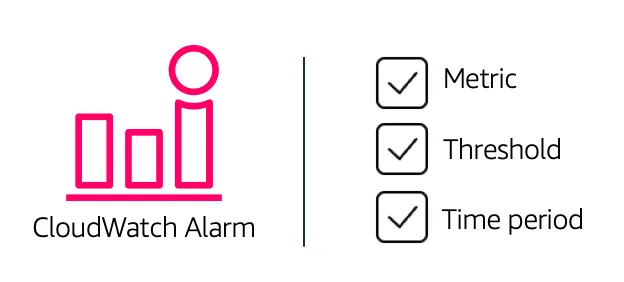"Mastering AWS CloudWatch Alarms: A Symphony of Monitoring and Automation"
 Sumit Mondal
Sumit Mondal
Introduction:
In the vast realm of cloud computing, Amazon Web Services (AWS) stands tall, offering a plethora of services to cater to diverse business needs. Among these, AWS CloudWatch emerges as a crucial player, providing a comprehensive suite for monitoring, logging, and alerting. In this blog post, we'll delve into the heart of CloudWatch - its alarm system, exploring how CloudWatch Alarms can orchestrate a symphony of monitoring and automation for your AWS infrastructure.
Understanding AWS CloudWatch Alarms:
AWS CloudWatch Alarms are a powerful mechanism to keep a vigilant eye on your cloud resources. Essentially, an alarm monitors a specific metric over a defined period and triggers an action based on the configured threshold. This mechanism allows you to react promptly to changes in your environment, ensuring optimal performance and resource utilization.
Creating an Alarm:
Let's take a hands-on approach to understand how to create an alarm in AWS CloudWatch. Assume we have an Amazon EC2 instance running a critical application, and we want to be notified if the CPU utilization crosses a certain threshold.
Navigate to CloudWatch: Log in to the AWS Management Console and navigate to the CloudWatch service.
Access Alarms: In the CloudWatch dashboard, select "Alarms" from the left-hand navigation pane.
Create Alarm: Click on the "Create Alarm" button to initiate the alarm creation process.
Select Metric: Choose the metric you want to monitor. In this case, select the EC2 namespace and then the "CPUUtilization" metric.
Define Conditions: Set the conditions for your alarm. For instance, you might set the threshold to trigger an alarm when the CPU utilization exceeds 80% over a specified time period.
Configure Actions: Define the actions to be taken when the alarm state changes. This could include sending a notification to an Amazon SNS topic, triggering an Auto Scaling policy, or even stopping or terminating an instance.
Review and Create: Review your configurations and click "Create Alarm" to finalize the setup.
Congratulations! You've just created your first CloudWatch Alarm. Now, let's explore some advanced features and real-world use cases.
Advanced Features of CloudWatch Alarms:
Composite Alarms: CloudWatch allows you to create composite alarms by combining multiple alarms with logical operators. This is particularly useful when you want to create complex conditions for triggering actions.
{ "logicalOperator": "OR", "alarmRule": "(ALARM(State='ALARM' AND MetricName='CPUUtilization') OR ALARM(State='OK' AND MetricName='StatusCheckFailed'))" }Anomaly Detection: Leveraging machine learning, CloudWatch offers anomaly detection for metrics. This allows the system to automatically adapt to changing patterns and trigger alarms when unexpected deviations occur.
{ "statisticalThreshold": { "comparisonOperator": "GreaterThanOrEqualToThreshold", "threshold": 2.5, "numberOfDatapoints": 3 } }Period and Evaluation Period: Understanding the concepts of period and evaluation period is crucial. The period defines the granularity of the metric data, while the evaluation period determines how many consecutive periods must breach the threshold for the alarm to trigger.
{ "period": 300, "evaluationPeriods": 2 }
Real-World Use Cases:
Auto Scaling Based on CloudWatch Alarms: Integrate CloudWatch Alarms with Auto Scaling policies to dynamically adjust the number of instances based on metrics like CPU utilization. This ensures your application can handle varying loads efficiently.
Cost Optimization: Set up alarms to monitor costs and receive notifications when expenses exceed predefined limits. This proactive approach enables you to optimize resource usage and prevent unexpected bills.
Security and Compliance: Employ CloudWatch Alarms to monitor security-related metrics such as failed login attempts or unauthorized access. This enhances your ability to detect and respond to potential security threats promptly.
Conclusion:
AWS CloudWatch Alarms are the conductors of a finely tuned orchestra, allowing you to harmonize the performance of your cloud resources. By mastering the art of creating alarms, understanding advanced features, and applying them to real-world scenarios, you empower yourself to build a resilient, scalable, and cost-efficient cloud infrastructure.
As you continue your AWS journey, remember that CloudWatch Alarms are not just tools for monitoring; they are instruments of proactive management and optimization in the ever-evolving cloud landscape. Keep monitoring, keep optimizing, and let CloudWatch Alarms be the melody that guides your AWS experience.
Subscribe to my newsletter
Read articles from Sumit Mondal directly inside your inbox. Subscribe to the newsletter, and don't miss out.
Written by

Sumit Mondal
Sumit Mondal
Hello Hashnode Community! I'm Sumit Mondal, your friendly neighborhood DevOps Engineer on a mission to elevate the world of software development and operations! Join me on Hashnode, and let's code, deploy, and innovate our way to success! Together, we'll shape the future of DevOps one commit at a time. #DevOps #Automation #ContinuousDelivery #HashnodeHero